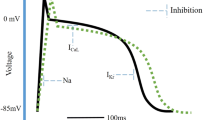Summary
Seven patients with cardiac arrhythmias were given amiodarone 400 mg intravenously over 2 min, and 2–4 days later the same dose was given orally. The serum concentration of amiodarone was determined by HPLC; the sensitivity of the analysis was 0.1 µg/ml. The time sequence of the measurements of drug concentration made conventional compartemental analysis impossible. There was large individual variation but some of the curves suggested enterohepatic circulation. The time from oral intake to the peak serum concentration was estimated to be 7.3±2.9 h (SD). The “amount of drug reaching the general circulation in 24 h after oral intake” averaged 42% (22–80%). After oral administration of amiodarone 200 mg 8 hourly the serum concentration before the morning dose averaged 0.61 µg/ml after 24 h, 0.76 after 48 h, 1.18 after 1 week and 1.56 µg/ml after 1 month. In one patient, who had been on amiodarone therapy for 8 months, the drug was discontinued and the serum concentration was followed over the next 3 months. The drug elimination curve suggested an elimination half life of 13.7 days. Because of instability in physiological saline protein binding could not be precisely quantitated, but only characterized as strong. No unchanged amiodarone was found in urine. The urinary excretion of iodine over 2 h after intravenous administration suggested that 5% of orally administered amiodarone was eliminated in the urine after biotransformation. No effect of the drug was observed during the first 10 days of treatment. In 2 patients with supraventricular arrhythmia, an excellent response was seen, and in one with ventricular arrhythmia there was a good response.
Similar content being viewed by others
References
Bergdahl B (1977) An account of proscillaridin with special reference to its pharmacokinetics. Linköping University
Broekhuysen J, Laurel R, Sion R (1969) Etude compres du transit et du metabolisme de l'amiodarone chez diverses especes animales et chez l'homme. Arch Int Pharmacodyn Ther 177: 340–359
Charlier R, Baudine A, Chaillet F, Deltour G (1967) Recherches dans la serie des benzofurannes XXV. — Effects hemodynamiques de l'amiodarone chez le chien. Acta Cardiol 22: 324–349
Christensen JH, Andreasen F, Bjørn Jensen E (1980) The binding of thiopental to serum proteins determined by ultrafiltration and equilibrium dialysis. Acta Pharmacol Toxicol 47: 24–32
Flanagan RJ, Storey GCA, Holt DW (1980) Rapid high-performance liquid chromatographic method for the measurement of amiodarone in blood plasma or serum at the concentrations attained during therapy. J Chromatogr 187: 391–398
Geerts ML (1971) Amiodarone pigmentation. An electron microscopic study. Arch Belg Dermatol 23: 339–351
Grand A (1975) Myxoedeme a l'amiodarone. Coeur Med Interne 14: 163–167
Jonckheer MH, Blockx P, Kaivers R, et al. (1973) Hyperthyroidism as a possible complication of the treatment of ischemic heart disease with amiodarone. Acta Cardiol 28: 192–200
Rosenbaum MB, Chiale PA, Ryba D (1974) Control of tachyarrhythmias associated with Wolff-Parkinson-White syndrome by amiodarone hydrochloride. Am J Cardiol 34: 215–223
Rosenbaum MB, Chiale PA, Nau GJ, Przybylski J, Levi RJ, Lazzari JO, Elizari MV (1976) Clinical Efficacy of amiodarone as an antiarrhythmic agent. Am J Cardiol 38: 934–944
Vastesaeger M, Gillot P, Rasson G (1967) Etude clinique d'une nouvelle medication anti-angoreuse. Acta Cardiol 22: 483–500
Wanet J, Achten G, Barchewitz G, et al. (1971) Amiodarone et depots cutanes. Etude clinique et histologique. Ann Dermatol Syphiligr (Paris) 98: 131–140
Zipes DP, Troup PJ (1978) New Antiarrhythmic Agents. Amiodarone, aprindine, disopyramide, ethmozin, mexiletine, tocainide, verapamil. Am J Cardiol 41: 1005–1024
Author information
Authors and Affiliations
Rights and permissions
About this article
Cite this article
Andreasen, F., Agerbæk, H., Bjerregaard, P. et al. Pharmacokinetics of amiodarone after intravenous and oral administration. Eur J Clin Pharmacol 19, 293–299 (1981). https://doi.org/10.1007/BF00562807
Received:
Accepted:
Issue Date:
DOI: https://doi.org/10.1007/BF00562807




